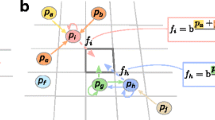Abstract
In group-structured populations, altruistic cooperation among unrelated group members may be sustainable even when the evolution of behavioral traits is governed by a payoff-based replicator dynamic. This paper explores the importance in this dynamic of two aspects of group structure: global or local interaction in a public goods game and global or local cultural transmission (learning) of behavioral traits. To clarify the underlying dynamic, I derive an extension of the Price equation for the decomposition of changes in the population frequency of a binary trait. I use this to analyze the effect of different structures of interaction and learning on within- and between-group variances of the frequency of cooperative behaviors and thereby on the evolution of cooperation. Of the four population structures given by global/local learning and global/local interaction, local interaction with global learning provides the most favorable environment for the evolution of cooperation. This combination of learning and interaction structures supports a high level of between-group variance in the frequency of cooperative types, so that most cooperators benefit from being in groups composed mostly of cooperators. However, while global learning is essential to the evolution of cooperation, cooperation is more robust when learning is not entirely global because local learning process, ironically, limits the extent to which defectors can free ride on cooperative group members.
Similar content being viewed by others
References
Axelrod R. (1986) An evolutionary approach to norms. The American Political Science Review 80(4): 1095–1111
Bergstrom T.C. (2002) Evolution of social behavior: Individual and group selection. Journal of Economic Perspectives 16(2): 67–88
Bergstrom T.C. (2003) The algebra of assortativity and the evolution of cooperation. International Game Theory Review 5: 211–228
Binford L.R. (2001) Constructing frames of reference. University of California Press, Berkeley, California
Boehm C. (1997) Impact of the human egalitarian syndrome on Darwinian selection mechanics. American Naturalist 150: S100–S121
Bowles S., Choi J.-K., Hopfensitz A. (2003) The coevolution of individual behaviors and social institutions. Journal of Theoretical Biology 233(2): 135–147
Boyd R., Richerson P.J. (1985) Culture and the evolutionary process. University of Chicago Press, Chicago
Boyd R., Richerson P.J. (1988) The evolution of reciprocity in sizable groups. Journal of Theoretical Biology 132: 337–356
Boyd R., Richerson P.J. (1992) Punishment allows the evolution of cooperation (or anything else) in sizable groups. Ethology and Sociobiology 13(3): 171–195
Boyd R., Richerson P.J. (2002) Group beneficial norms can spread rapidly in a structured population. Journal of Theoretical Biology 215: 287–296
Boyd R., Gintis H., Bowles S., Richerson P.J. (2003) The evolution of altruistic punishment. Proceedings of the National Academy of Science 100(6): 3531–3535
Cohen D., Eshel I. (1976) On the founder effect and the evolution of altruistic traits. Theoretical Population Biology 10: 276–302
Dawes R.M., Thaler R.H. (1988) Anomalies: Cooperation. Journal of Economic Perspectives 2(3): 187–197
Fehr E., Gachter S. (2000) Fairness and retaliation: The economics of reciprocity. Journal of Economic Perspectives 14(3): 159–181
Grafen A. (1979) The hawk-dove game played between relatives. Animal Behaviour 27: 905–907
Hamilton W.D. (1964) The genetical theory of social behaviour. Journal of Theoretical Biology 7: 1–52
Kaplan H., Gurven M., Hill K. (2005) The natural history of human food sharing and cooperation: A review and a new multi-individual approach to the negotiation of norms. In: Gintis H., Bowles S., Boyd R., Fehr E. (eds) Moral sentiments and material interests: On the foundations of cooperation in economic life. MIT Press, Cambridge, MA
Knudsen T. (2002) The evolution of cooperation in structured population. Constitutional Political Economy 13(2): 129–148
Landa J.T. (1981) A theory of the ethnically homogeneous middleman group: An institutional alternative to contract law. Journal of Legal Studies 10(2): 349–362
Landa J.T. (1999) The law and bioeconomics of ethnic cooperation and conflict in plural societies of Southeast Asia: A theory of Chinese merchant success. Journal of Bioeconomics 1(3): 269–284
Maynard Smith J. (1964) Group selection and kin selection. Nature 201(4924): 1145–1147
Mitteldorf J., Wilson D.S. (2000) Population viscosity and the evolution of altruism. Journal of Theoretical Biology 204: 481–496
Myerson R.B., Pollock G.B., Swinkels J.M. (1991) Viscous population equilibria. Games and Economic Behavior 3: 101–109
Price G.R. (1972) Extension of covariance selection mathematics. Annals of Human Genetics 35: 485–490
Skyrms B. (2004) The stag hunt and the evolution of social structure. Cambridge University Press, Cambridge, MA
Wade M.J. (1978) A critical review of the models of group selection. Quarterly Review of Biology 53(2): 101–114
Wilson D.S. (1975) A theory of group selection. Proceedings of the National Academy of Sciences of the United States of America 72(1): 143–146
Wilson D.S. (1977) Structured demes and the evolution of group-advantageous traits. American Naturalist 111(977): 157–185
Wilson D.S. (1979) Structured demes and trait-group variation. American Naturalist 113(4): 606–610
Wilson D.S., Pollock G.B., Dugatkin L.A. (1992) Can altruism evolve in purely viscous populations? Evolutionary Ecology 6: 331–341
Wilson D.S., Sober E. (1994) Reintroducing group selection to the human behavioral sciences. Behavioral and Brain Sciences 17(4): 585–654
Wright S. (1945) Tempo and mode in evolution: A critical review. Ecology 26(4): 415–419
Author information
Authors and Affiliations
Corresponding author
Rights and permissions
About this article
Cite this article
Choi, JK. Play locally, learn globally: group selection and structural basis of cooperation. J Bioecon 10, 239–257 (2008). https://doi.org/10.1007/s10818-008-9039-4
Published:
Issue Date:
DOI: https://doi.org/10.1007/s10818-008-9039-4
Keywords
- The evolution of cooperation
- Global/local play
- Global/local learning
- Between-group variance
- Within-group variance




